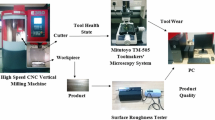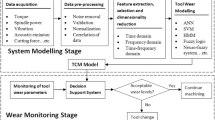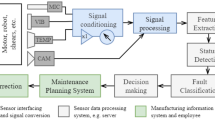Abstract
Presented in this work is a novel tool-condition criterion dubbed as the current rise criterion (CRC). This criterion is based on the measured current values of the machine tool’s spindle and drive motors. The CRC comprises two components: (1) the current rise index (CRI) and (2) a sensitivity factor (SF) indicated as a subscript to the CRI. Current rise criterion is described mathematically as CRC = CRI SF . The CRI that accounts for the damage (including wear) suffered by the tool is calculated as the square root of the sum of the squared percent increase in the root mean square (RMS) current values of the spindle and drive motors. To indicate the relative contribution of each of the machine tool motors to the CRI, the sensitivity factor (SF) reflects the ratio of the drive motor current percent rise to that of the spindle motor. The reference current used in calculating the percent rise of the motor current for both CRI and SF is measured at the first cut of the fresh tool. The versatility of the CRC was demonstrated here using two different machining processes: milling and drilling. Quantitative polar maps of the CRI and the associated sensitivity factor of cutting tools as well as qualitative descriptions of the various modes of tool condition afflicting the cutting tools are presented. CRC is demonstrated to be capable of monitoring the tool condition for a variety of cutting parameters of speeds and feeds. Another study demonstrated the versatility of CRC as a discriminator of the quality of chisel drills. It was found that the criterion successfully tracks the tool condition along a variety of process levels. CRC may be used to monitor tool condition and prognostics across practically all machining operations and process parameters, thus rendering the criterion “process independent.” CRC can also be used to monitor the change in power consumption of machine tools while cutting with worn tools.
Similar content being viewed by others
References
Rehorn AG, Jiang J, Orban PE (2005) State-of-the-art methods and results in tool condition monitoring: a review. Int J Adv Manuf Tech 26:7–8, 693-710
Teti R, Jemielniak K, O’Donnell G, Dornfeld D (2010) Advanced monitoring of machining operations. CIRP Ann Manuf Technol 59:717–739
Kurada S, Bradley C (1997) A review of machine vision sensors for tool condition monitoring. Comput Ind 34:55–72
Byrne G, Dornfeld D, Inasaki I, Ketteler G, König W, Teti R (1995) Tool condition monitoring (TCM)—the status of research and industrial application. CIRP Ann Manuf Technol 44:541–567
Patra K, Pal SK, Bhattacharyya K (2007) Artificial neural network based prediction of drill flank wear from motor current signals. Appl Soft Comput 7:929–935
Ammouri AH, Hamade RF (2011) Indirect tool-wear maps for tool condition monitoring in dry metal drilling operations. In: Seliger G, Khraisheh MMK, Jawahir IS (eds) Advances in sustainable manufacturing. Springer, Heidelberg, pp 115–120
Ketteler G (1999) Influences on monitoring systems which affect their reliability, 2nd int. Workshop on Intell. Manuf. Syst, Leuven, pp 769–777
Al-Sulaiman FA, Baseer MA, Sheikh AK (2005) Use of electrical power for online monitoring of tool condition. J Mater Process Technol 166:364–371
Franco-Gasca LA, Herrera-Ruiz G, Peniche-Vera R, Romero-Troncoso RJ, Leal-Tafolla W (2006) Sensorless tool failure monitoring system for drilling machines. Int J Mach Tools Manuf 46:381–386
Dahmus JB, Gutowski TG (2004) An environmental analysis of machining, American Society of Mechanical Engineers, Manufacturing Engineering Division. MED 15:643–652
R. Hamade, A. Ammouri, Current rise index (CRI) maps of machine tool motors for tool-wear prognostic, ASME 2011 International Mechanical Engineering Congress and Exposition (IMECE2011), November 11–17, 2011, Denver, Colorado, USA
Pritschow G, Kramer C (2005) Open system architecture for drives. CIRP Ann-Manuf Technol 54:375–378
Oraby S, Hayhurst D (2004) Tool life determination based on the measurement of wear and tool force ratio variation. Int J Mach Tools Manuf 44:1261–1269
Hamade R, Seif C, Ismail F (2006) Extracting cutting force coefficients from drilling experiments. Int J Mach Tools Manuf 46:387–396
Author information
Authors and Affiliations
Corresponding author
Rights and permissions
About this article
Cite this article
Ammouri, A.H., Hamade, R.F. Current rise criterion: a process-independent method for tool-condition monitoring and prognostics. Int J Adv Manuf Technol 72, 509–519 (2014). https://doi.org/10.1007/s00170-014-5679-9
Received:
Accepted:
Published:
Issue Date:
DOI: https://doi.org/10.1007/s00170-014-5679-9




